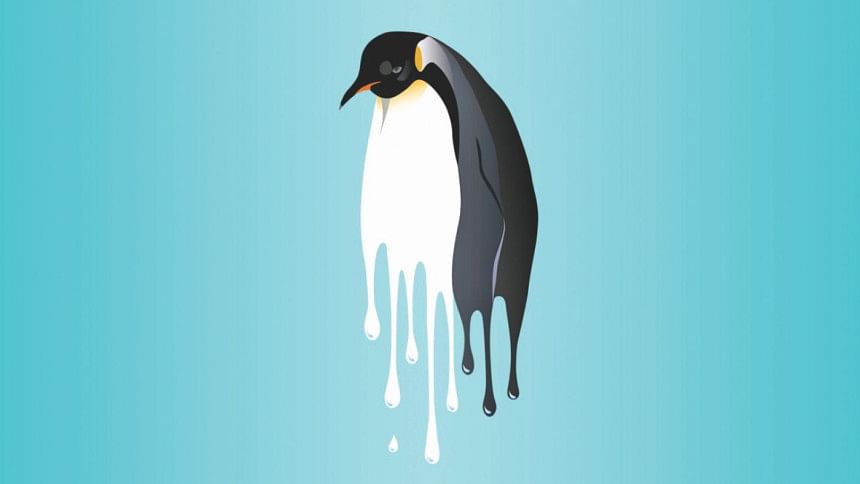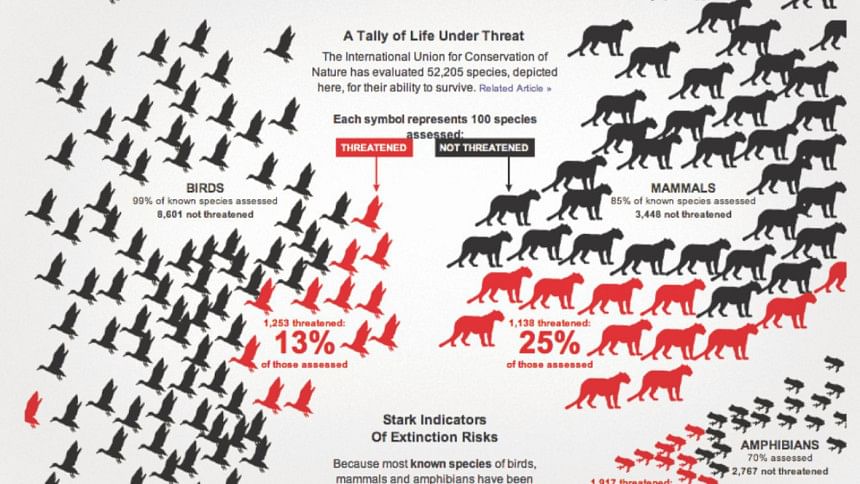CAN WE DEFEAT THE SIXTH MASS EXTINCTION?

Over the last two centuries, humans have caused irreparable damage to the environment. Forests, rivers, hills, and seas have turned upside down and species displaced for food and shelter.
In the last 50 years, humans have done so much damage to the environment that it might be impossible to make any tangible recovery, according to a report, Millennium Ecosystem Assessment (MEA), published by the UN.
Currently the rate of extinction of both plants and animals is much higher than normal. Although extinction of one species in a million per year is considered normal, conservation ecologist from Duke University, Dr Stuart Pimm, and curator of palaeonology department of American Museum of Natural History, Dr Michael Novak, believe the rate of extinction of different species will be 1000 times the natural rate within the next few decades; and 50 percent of the world's species will be lost forever within the next century. This cannot be considered normal.
Many biologists suspect we are living through the sixth mass extinction. We have witnessed five mass extinctions before, where more than 75 percent of all species disappeared. The first mass extinction happened due to a severe ice age, the second mass extinction due to algal bloom in the sea, which sucked oxygen out of the water and the the third mass extinction also known as “The Great Dying” happened due to a cataclysmic eruption near Siberia which blasted CO2 in the atmosphere. Consecutively, the fourth was caused by a meteor shower while the fifth mass extinction was caused by natural climate events. All the above mass extinctions took place due to natural reasons. However, scientists believe, we are now going through the sixth mass extinction and it is happening due to human activities at a rate much faster than all the previous ones.
Below, we take a look at some of the possible causes behind the sixth mass extinction.
Forest cover loss
Rampant urbanisation has resulted in the destruction of forests and habitats of thousands of animals, birds, butterflies, and bees. For example, owing to habitat losses, orangutans and honey bees are both facing extinction threats. Both species are responsible for fruit seed dispersal and pollination respectively. Now if both disappear, the world will face immense food shortage and eventually famine.
Monoculture and invasive species
By introducing a new species in an ecosystem, the whole ecological balance could be harmed. The new species might have been harmless in its original habitat but it can be aggressive in its new environment. It can spread diseases and even put the existence of other species at great risk. For example, the African Magur was not invasive in its homeland, but our experience suggests that it is much bigger in size and aggressive in nature when it is cultivated in Bangladesh. Humans are importing species from many places and practicing monoculture that drives ecological damage.
Nitrogen and Phosphorus Cycle
Humans have almost broken the natural cycle of nitrogen and phosphorus due to industrial and agricultural purposes. We know that plants need nitrogen and phosphorus for their growth. Since we use synthetic fertiliser to maintain proper soil nutrition, we are artificially producing nitrogen and phosphorus fertilisers. Trees can utilise only 5 percent of the fertiliser while 95 percent washes away due to rain and is deposited in the nearest water body; finally it makes way to estuaries and coastal areas flowing through the river. When huge amounts of nitrogen and phosphorus are deposited into water bodies, algal bloom occurs. When the algae decompose, it ends up consuming almost all the oxygen in the water body. This results in the water body running out of oxygen, something that is called the Hypoxic zone. In a hypoxic zone all biodiversity is threatened. Those who can move, quickly move away from that place; however most of them die and eventually that place becomes a dead zone—as it did in the Haor area of Bangladesh last year. There are almost 405 dead or Hypoxic zones in the world, which was only numbered at 49 in 1960s.

Land system reform
Around the world, humans have changed the indigenous land system use for their own purposes. A rapid change in land system is the key reason behind decreasing biodiversity. People have also modified river systems and its course. In 2017, hundreds of people were killed in the Chittagong Hill Tracts in landslides. Such incidents are happening everywhere in the world where unplanned urbanisation takes place.
Climate Change
Climate change has resulted in increased global temperatures, heat waves, rising sea-levels threatening coastal communities, water stress, extreme weather events such as flash floods, drought, waterlogging, food scarcity, increased salinity, ocean acidification, and so on. Fossil fuels have increased the amount of CO2 in the atmosphere and changed the local and global climate. In the last century, the average temperature of the planet increased by 1 degree Celsius. There could be a 5 to 6 degree Celsius increase in temperature by the end of this century. This has devastating environmental consequences. Most of the ice and glaciers in Greenland and Arctic will melt, resulting in sea level rise inundating coastal communities. Millions of people will become climate refugees. Intensity of monsoon storm and cyclone will increase.
Fresh water consumption, river course change, and hydrological cycle
The consumption of fresh water tripled in the last 50 years. The global reserve of fresh water is at high risk due to climate change. Study indicates that ground water reserve is decreasing all over the world due to a broken hydrological cycle. The ground water system is like a massive battery. Water from surface leaks through the soil and is stored as ground water. We collect that water for our use; however if it fails to refill as much water as we uptake, the level of ground water tends to decrease.
Ocean acidification and pollution
Life on earth depends upon the availability of oxygen. Half of the oxygen in the air that supports life on earth is supplied by the ocean. More specifically by the phytoplanktons floating in the ocean. Wide spread fishing, commercial shipping line movement, waste disposal, plastic pollution have already threatened the ocean ecosystem. With all these, climate change has brought some additional pain. While the concentration of CO2 increases in the atmosphere, it continuously dissolves with ocean water and forms carbonic acid and decreases the pH. The increased acidity reduces the available carbonate ions in the upper surface of the water, which is the basic building block for many marine species for shell and skeleton formation. Beyond a threshold concentration, this rising acidity makes it hard for organisms such as corals, some shellfish, and plankton species to grow and survive. Finally phytoplanktons are decreasing in the oceans, which are the basic building blocks of life on earth. Increased acidity has threatened these species too. If this continues, within the next five decades our oceans will lose all of its phytoplanktons and the fish production will drop significantly, oxygen level in the atmosphere will decrease and all our oceans will become near dead zones.
Among all the above mentioned problems, climate change is the simplest to solve. At least we all know what to do. Other problems are much more complicated. We have to work a lot on forest, fresh water, land system reform, nitrogen and phosphorous cycle and most importantly in the sector of biosphere integrity. Both individual and collective actions are needed. In the course of development the environmental damage done by the big nations was horrific but in this age of information we should not follow the same course.
Mahbub Sumon is an environment and renewable energy expert.

 For all latest news, follow The Daily Star's Google News channel.
For all latest news, follow The Daily Star's Google News channel. 



Comments